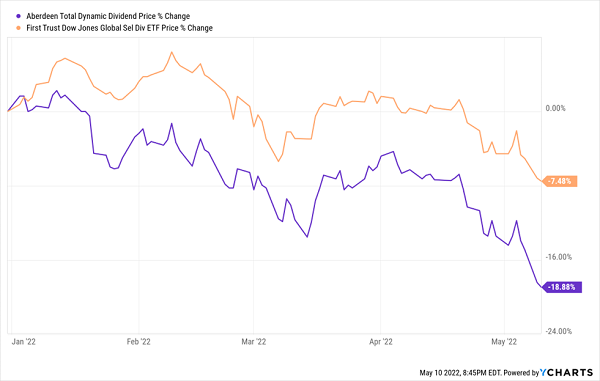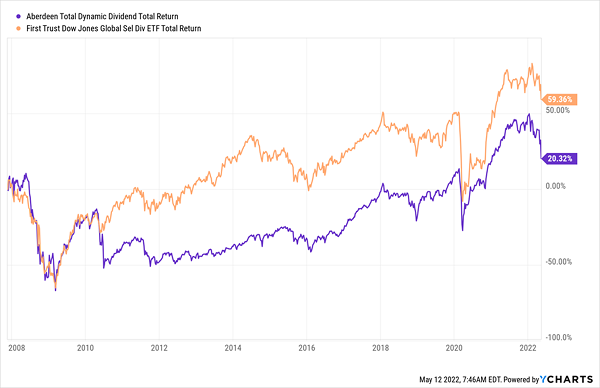Every legendary investor worth their salt has some sort of phrase to describe what investors should be doing right this very minute.
“Be fearful when others are greedy, be greedy when others are fearful.”
“Buy when there’s blood in the streets.”
Largely speaking, most stocks on the market are on sale to some extent. And sure, we could go out and make a few targeted bets on these bargains.
But I’d prefer to squeeze even more value out of the stock market.
Enter closed-end funds (CEFs).
Why CEFs Are Our Best Option Now
If we were to go out and buy an exchange-traded fund (ETF) that invests in, say, the NASDAQ Composite or Russell 2000, or really any area of the market you felt was underpriced, you’d be able to enjoy in the collective discounts of all their holdings. No more, no less.
But with CEFs, we can do even better.
My mom, to this day, refuses to pay the sticker price. If there’s a coupon to be found, she’ll not only find it, but she’ll also find another coupon to secure a double-discount (even if it requires management approval to apply)!
And just like my mom, we can secure a double-discount by investing through closed-end funds.
You see, unlike ETFs, which can create and destroy as many shares as needed to meet market demand, CEFs go public with a specific number of units, and that number doesn’t really change over time.
Because of that, CEFs’ net asset value can become untethered from the value of its holdings. Sometimes, that NAV can be worth significantly more, in which case the closed-end fund will trade at a premium, say $1.05 for every $1 in holdings.
But sometimes, you get the better other edge of that sword, and buy a CEF at a discount to NAV, paying, say, 95 cents for every $1 in holdings.
When you combine that with a broader market that’s already on sale, we contrarians can take a page out of my mom’s playbook and get a double-discount that, in the case of the five funds that I’m about to show you, can allow us to purchase shares for as little as 81 cents on the dollar!
Let me introduce you to five CEFs that will allow you to do exactly that. And in addition to trading at a significant discount (of 10% or more), these funds offer fat yields of 7% and more—and better still, pay out their distributions each and every month.
We’ll start out with a fund that’s actually doing quite well this year:
1. First Trust MLP And Income Closed Fund - 7.7% yield
Energy has been the market’s hottest sector in 2022, and it’s not even close. The sector is up 38% so far—and it’s the only one in positive territory! Second-best is utilities with “just” a 1% decline.
That said, energy-infrastructure master limited partnerships (MLPs) haven’t been quite as explosive. First Trust’s, for instance, is up just 7%, which is far behind the broader energy sector and only half as good as most indexed MLP exchange-traded funds.
Oil Prices Are Flying, But FEI Is Just Hovering a Little
Conversely, FEI might be one of the only energy-sector bargains left.
First Trust MLP & Income Closed Fund (NYSE:FEI) is a tight, concentrated portfolio of infrastructure plays primarily dealing in petroleum, natural gas, electric power and crude oil transmission.
Industry blue chips such as Enterprise Products Partners LP (NYSE:EPD) and Magellan Midstream Partners LP (NYSE:MMP) anchor the top holdings list. That naturally would lead to a high overall yield, but about 20% in debt leverage helps FEI juice its payout to nearly 8% at current prices.
Value investors will love that they’re getting twice the bargain right now, at a discount to NAV of 14%, which is double the CEF’s five-year historical discount of about 7%.
You can find a couple more double-digit discounts to NAV in the following CEFs:
2. & 3. Neuberger Berman Next Generation Connectivity Fund - 11.4% Yield; MainStay CBRE Global Infrastructure Megatrends Fund - 7.7% Yield
The first thing that stands out? These aren’t traditional CEFs.
Neuberger Berman’s NBXG looks for stocks with growth potential from “the development, advancement, use or sale of products, processes or services related to the fifth-generation mobile network and future generations of mobile network connectivity and technology.” In other words, 5G stocks. NVIDIA (NASDAQ:NVDA). Palo Alto Networks (NASDAQ:PANW), and Globant (NYSE:GLOB).
MainStay’s MEGI is a little less straightforward. The firm says its fund is “focused on the investment megatrends of decarbonization, digital transformation and asset modernization, which are reshaping the demand for infrastructure assets and driving income and growth potential.”
The portfolio itself is pretty much an energy fund with some focus on renewables—top holdings include National Grid (LON:NG) (NYSE:NGG), Williams Companies (NYSE:WMB) and Atlantica Sustainable Infrastructure PLC (NASDAQ:AY).
In short, they’re thematics—a type of fund that can cross sectors to harness an investable theme. They’re big in ETFs; not so much in CEFs. But, NBXG and MEGI are a new breed. Very new, in fact. Both started trading in 2021 and have very little trading history, though both are getting pounded this year.
Tough Love For The New Kids

Both also trade at mouth-watering discounts (NBXG: -18.4%; MEGI: -13.2%), though both also have very little history to compare that to.
They’re ambitious offerings that could shake up the CEF world. But it’s hard to tell whether you can depend on them for income—monthly dividends and all.
4. BlackRock Health Sciences Trust II - 11.4% Yield
BlackRock Health Sciences Trust II (NYSE:BMEZ) is on the greener side, too, having launched in January 2020. And despite the seemingly specific name, this is just a broad, actively managed healthcare fund. Holdings are split roughly 50-50 between pharma/biotech/life sciences and health care equipment/services.
Thus, top holdings include everything from biotech Vertex Pharmaceuticals (NASDAQ:VRTX) to insurer Anthem (NYSE:ANTM) to Japanese Big Pharma firm Daiichi Sankyo Co Ltd ADR (OTC:DSNKY).
It’s hard to know what to make of this young fund, though.
BlackRock’s CEF Has Taken A Dive In 2022

BMEZ is off roughly 40% in 2022 versus a mere 10% loss for the broader healthcare sector. You can’t blame leverage, either—the fund only uses a marginal amount.
This looks like simply unfortunate decisions coming to roost, but more than a year ago, Wall Street would have been patting fund management on the back for its wide outperformance.
If you still want to take a chance on BMEZ, though, you couldn’t ask for a better price. It currently trades at a 14% discount, or 86 cents on the dollar—more than double its 6.4% one-year average—for an 11% yield paid monthly.
5. Aberdeen Total Dynamic Dividend - 8.4% Yield
If you’re looking for something really simple and straightforward, it doesn’t get much more basic than the Aberdeen Total Dynamic Dividend Fund (NYSE:AOD), which is trading at a 12% discount to NAV that’s slightly better than its norm. This is a global fund that seeks to pay out high dividends. If it delivers capital gains, great, but that’s secondary to the cash.
So far in 2022, it’s clear that capital gains are secondary.
AOD Has Struggled Out Of The Gate

“Global,” for the uninitiated, is Wall Street for “domestic and international.” Typically, global funds are at least half-invested in U.S. stocks (AOD is, at 53%), with the rest spread around a number of developed and/or emerging markets. Here, AOD has single-digit weights to France, Germany, Switzerland and a host of primarily developed markets.
The problem is, despite having a fairly growthy portfolio that includes the likes of Apple (NASDAQ:AAPL), Microsoft (NASDAQ:MSFT), and Alphabet (NASDAQ:GOOGL), AOD has actually been a laggard over the very long term.
This Global Dividend Index Fund Has AOD Beat

This is why it pays to look beyond headline yield. Because despite yielding a massive 8%-plus and holding onto stocks that have been on fire over the past decade or so, AOD still has struggled to match, let alone beat, cheaper indexed products.
Disclosure: Brett Owens and Michael Foster are contrarian income investors who look for undervalued stocks/funds across the U.S. markets. Click here to learn how to profit from their strategies in the latest report, "7 Great Dividend Growth Stocks for a Secure Retirement."
